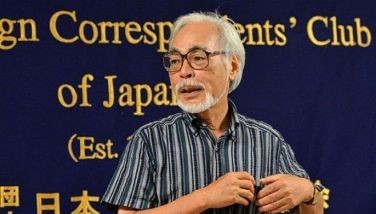Movie icons immortalized in Gems of Philippine History (Second of two parts)
MANILA, Philippines - Did you know that in the first film that he directed, Lamberto Avellana built a typical native village which he realistically set on fire?
That Lino Brocka was the first Filipino Mormon convert?
And that Gerardo de Leon dropped his real family name (Ilagan) and adopted his mother’s surname (De Leon) because “He thought it was embarrassing to see so many Ilagans in the film industry?”
These and other less known facts about the lives of Philippine movie industry icons are brought to the fore in a just-launched book titled Gems of Philippine History: Inspiring Lives of 150 Great Filipinos written by Dr. Fernando Bernardo.
Accounts of Avellana, Brocka, De Leon, Jose Nepomuceno, Narcisa Vda. de Leon, Wilfrido Ma. Guerrero and Severino Reyes constitute the book’s Chapter XI titled Dramatists and Movie Producers.
Bernardo dubbed Avellana, Outstanding Film Director and Master of Realism, a reputation he had earned for creating “life-like” scenes in his movies.
This is exemplified by the first film he directed, Sakay, a story of a patriot (“bandit” to others) who led an armed struggle against the Americans. For his debut film, Avellana built a typical village which he put to the torch to make the movie scenes “totally life-like.”
Born in Bontoc, Mt. Province, on Feb. 12, 1905, he wanted to become a doctor but shifted to arts as an influence of Jesuit priest Fr. Henry Lee Irwin, a respected Shakespearean actor. He obtained a Bachelor of Arts degree, magna cum laude, from Ateneo de Manila University.
A powerful film, Sakay, was hailed as “a cinematic milestone in the history of Philippine movies,” pointed out Dr. Bernardo.
 Wilfrido Ma. Guerrero wrote and directed about 100 plays
Wilfrido Ma. Guerrero wrote and directed about 100 plays Inspired by his success in Sakay, Avellana directed 70 more films. He also produced, among other films, Walang Sugat, Lapu-Lapu, Kundiman ng Lahi, Sa Paanan ng Nazareno and Tandang Sora.
Anak Dalita, one of his unforgettable films, realistically portrayed ordinary Filipinos struggling to rise above misery and poverty brought about by the ravages of World War II. It won the FAMAS Best Picture award in 1956.
Avellana, who organized Documentary Incorporated which pioneered in Philippine documentary filming, succumbed to a heart attack in 1991 at age 86.
Lino Brocka was born in Nueva Ecija on April 3, 1939 out of wedlock to his teenage mother (15 years old) and a married skilled carpenter and boat builder, who subsequently was meted out a prison term for bigamy.
After serving his sentence, the elder Brocka continued to live with his second wife and two sons (Lino and Danilo) and became a village politician but eventually was killed. Thus, Lino had a hard life as a young boy.
But being intelligent, Lino won a scholarship to the University of the Philippines where he enrolled in pre-law course. He later dropped his course and took only subjects that interested him.
“By the time he left the university, he had earned enough English units for a master’s degree, but lacked freshman subjects to graduate,” Bernardo wrote.
As the first Filipino Mormon convert, Bernardo noted, Lino was sent to Hawaii as a missionary. He later went to San Francisco (USA) where he took odd jobs such as busboy and worker in a hospital for the elderly.
When he came back, he pursued his interest in theater.
His break came in 1970 when a movie producer asked him to do for Lea Production a film that was entered in the Manila Film Festival. The result was Wanted: Perfect Mother, which won the award for Best Screenplay.
Other films that earned for Lino Best Director awards were Santiago (1970); Tubog sa Ginto, a film about a wealthy homosexual; Stardom (1971); Maynila Sa Kuko ng Liwanag (1975); and Jaguar (1980), which also won the Best Director award at the Cannes Film Festival in France in 1977. (Lino was the first Filipino who “conquered Cannes.”)
Lino, a member of the 1986 Constitutional Convention but resigned while the Constitution was being framed, died in a car accident in Quezon City in 1991.
Gerardo de Leon, a doctor by profession, is the only Filipino filmmaker to be cited in the Petit Larousse du Cinema Mondial, Dr. Bernardo noted.
A UST alumnus, De Leon was too compassionate with his poor patients that he at times asked money from his mother to give to his patient to buy medicine.
“Thus, when he was lured to go into the movies full-time, he could not resist the temptation,” Bernardo wrote.
 Gerardo de Leon, a doctor by profession, is the only Filipino filmmaker to be cited in the prestigious Petit Larousse du Cinema Mondial
Gerardo de Leon, a doctor by profession, is the only Filipino filmmaker to be cited in the prestigious Petit Larousse du Cinema Mondial De Leon’s break came in 1939 when movie producer Pilar Hidalgo Lim asked him to direct Ama’t Ina. All in all, he produced and directed about 100 movies from the pre-war years until his death in 1981.
His films included Sisa (1951), Ifugao (1954), Bakya Mo Neneng (1958), Aawitan Kita (1959), Noli Me Tangere (1961), The Moises Padilla Story (1961), El Filibusterismo (1962) and Intramuros (1976).
His awards included the Maria Clara Award (1950), Golden Harvest (1955), Republic Cultural Heritage (1970), FAMAS Hall of Fame (1975) and Natatanging Gawad Urian (1978).
De Leon was conferred the National Artist Award posthumously in 1982, a year after he died at age 68.
Guerrero and Reyes were also included in the chapter citing movie producers and dramatists.
Described by Bernardo as Outstanding Playwright and Theater Director, Guerrero had written and directed about 100 plays.
A UP alumnus, Guerrero became director of the UP Dramatic Guild. Under his guidance, the Guild staged more than 120 local and foreign plays and in the process produced noted actors and directors, among them Lino.
Guerrero’s plays had been translated into and produced in various local and foreign languages. Twelve of his plays were included in 23 college and high school textbooks and some have been incorporated in the Russian Encyclopedia.
Guerrero’s Awards included the Rizal Pro-Patria (1961), Republic Cultural Heritage (1972) and National Artist for Theater (1997).
Born in Manila in 1861, Reyes, and alumnus of both UST and Colegio de San Juan de Letran, is considered the Father of Modern Tagalog Drama.
Walang Sugat, his popular dramatic masterpiece about the Philippine revolution, gave birth to the Golden Age of Zarzuela. The play was staged more than 500 times throughout the country.
When his playwriting career ended when movies became popular, he turned to writing novels and short stories, pioneering in children’s stories. He became widely known as Lola Basyang, his popular storytelling character in Mga Kuwento ni Lola Basyang. He wrote more than 400 Lola Basyang stories.
Reyes succumbed to a heart ailment in 1942 at age 81.
- Latest
- Trending




























 Exclusive
Exclusive